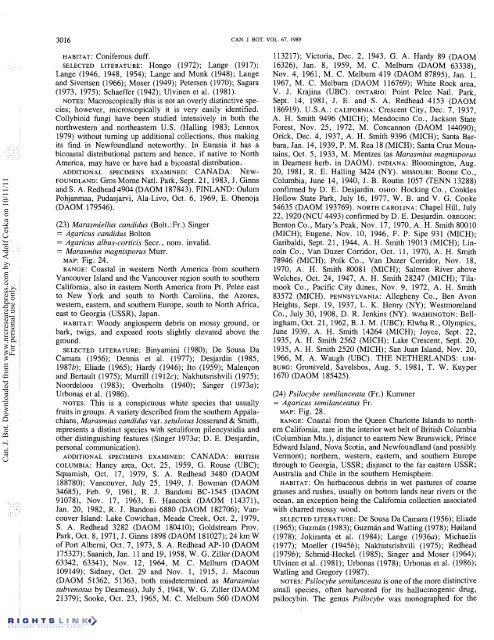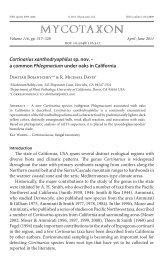Redhead Fungal Biogeography.pdf - Mushroom Hobby
Redhead Fungal Biogeography.pdf - Mushroom Hobby
Redhead Fungal Biogeography.pdf - Mushroom Hobby
You also want an ePaper? Increase the reach of your titles
YUMPU automatically turns print PDFs into web optimized ePapers that Google loves.
Can. J. Bot. Downloaded from www.nrcresearchpress.com by Adolf Ceska on 10/11/11<br />
For personal use only.<br />
3016<br />
Noordeloos (1983); Overholts (1940); Singer (1973a);<br />
Urbonas et al. (1986).<br />
NOTES: This is a conspicuous white species that usually<br />
fruits in groups. A variety described from the southern Appala-<br />
chians, Marasmius candidus var. setulosus Josserand & Smith,<br />
represents a distinct species with setuliform pileocystidia and<br />
other distinguishing features (Singer 1973a; D. E. Desjardin,<br />
personal communication).<br />
ADDITIONAL SPECIMENS EXAMINED: CANADA: BRITISH<br />
COLUMBIA: Haney area, Oct. 25, 1959, G. Rouse (UBC);<br />
Squamish, Oct. 17, 1979, S. A. <strong>Redhead</strong> 3480 (DAOM<br />
188780); Vancouver, July 25, 1949, J. Bowman (DAOM<br />
34685), Feb. 9, 1961, R. J. Bandoni BC-1545 (DAOM<br />
91078), Nov. 17, 1963, E. Hancock (DAOM 114371),<br />
Jan. 20, 1982, R. J. Bandoni 6880 (DAOM 182706); Vancouver<br />
Island: Lake Cowichan, Meade Creek, Oct. 2, 1979,<br />
S. A. <strong>Redhead</strong> 3282 (DAOM 180410); Goldstream Prov.<br />
Park, Oct. 8, 1971, J. Ginns 1898 (DAOM 181027); 24 krn W<br />
of Port Alberni, Oct. 7, 1973, S. A. <strong>Redhead</strong> AP-10 (DAOM<br />
175327); Saanich, Jan. 11 and 19, 1958, W. G. Ziller (DAOM<br />
63342, 63341), Nov. 12, 1964, M. C. Melburn (DAOM<br />
109149); Sidney, Oct. 29 and Nov. 1, 1915, J. Macoun<br />
(DAOM 5 1362, 5 1363, both misdetermined as Marasmius<br />
subvenosus by Dearness), July 5, 1948, W. G. Ziller (DAOM<br />
21379); Sooke, Oct. 23, 1965, M. C. Melburn 560 (DAOM<br />
CAN. J. BOT. VOL. 67, 1989<br />
HABITAT: Coniferous duff.<br />
113217); Victoria, Dec. 2, 1943, G. A. Hardy 89 (DAOM<br />
SELECTED LITERATURE: Hongo (1972); Lange (191 7); 16326), Jan. 8, 1959, M. C. Melburn (DAOM 63338),<br />
Lange (1946, 1948, 1954); Lange and Munk (1948); Lange Nov. 4, 1961, M. C. Melburn 419 (DAOM 87895), Jan. I,<br />
and Sivertsen (1966); Moser (1949); Petersen (1970); Sagara 1967, M. C. Melburn (DAOM 116769); White Rock area,<br />
(1973, 1975); Schaeffer (1942); Ulvinen et al. (1981). V. J. Krajina (UBC). ONTARIO: Point Pelee Natl. Park,<br />
NOTES: Macroscopically this is not an overly distinctive spe- Sept. 14, 1981, J. E. and S. A. <strong>Redhead</strong> 4153 (DAOM<br />
cies; however, microscopically it is very easily identified. 186919). U.S.A.: CALIFORNIA: Crescent City, Dec. 7, 1937,<br />
Collybioid fungi have been studied intensively in both the A. H. Smith 9496 (MICH); Mendocino Co., Jackson State<br />
northwestern and northeastern U.S. (Halling 1983; Lennox Forest, Nov. 25, 1972, M. Concannon (DAOM 144090);<br />
1979) without turning up additional collections, thus making Orick, Dec. 4, 1937, A. H. Smith 9396 (MICH); Santa Barits<br />
find in Newfoundland noteworthy. In Eurasia it has a bara, Jan. 14, 1939, P. M. Rea 18 (MICH); Santa Cruz Mounbicoastal<br />
distributional pattern and hence, if native to North tains, Oct. 5, 1933, M. Mentzes (as Marasmius magnisporus<br />
America, may have or have had a bicoastal distribution. in Dearness herb. in DAOM). INDIANA: Bloomington, Aug.<br />
ADDITIONAL SPECIMENS EXAMINED: CANADA: NEW- 20, 1981, R. E. Halling 3424 (NY). MISSOURI: Boone Co.,<br />
FOUNDLAND: Gros Morne Natl. Park, Sept. 2 1, 1983, J. Ginns Columbia, June 14, 1940, J. B. Routin 1057 (TENN 13288)<br />
and S. A. <strong>Redhead</strong> 4904 (DAOM 187843). FINLAND: Oulum confirmed by D. E. Desjardin. OHIO: Hocking Co., Conkles<br />
Pohjanmaa, Pudasjarvi, Ala-Livo, Oct. 6, 1969, E. Ohenoja Hollow State Park, July 16, 1977, W. B. and V. G. Cooke<br />
(DAOM 179546).<br />
54635 (DAOM 193769). NORTH CAROLINA: Chapel Hill, July<br />
22, 1920 (NCU 4493) confirmed by D. E. Desjardin. OREGON:<br />
(23) Marasmiellus candidus (Bolt. :Fr.) Singer<br />
Benton Co., Mary's Peak, Nov. 17, 1970, A. H. Smith 80010<br />
= Agaricus candidus Bolton<br />
(MICH); Eugene, Nov. 10, 1946, F. P. Sipe 931 (MICH);<br />
= Agaricus albus-corticis Secr., nom. invalid.<br />
Garibaldi, Sept. 21, 1944, A. H. Smith 19013 (MICH); Lin-<br />
= Marasmius magnisporus Mum.<br />
coln Co., Van Duzer Corridor, Oct. 11, 1970, A. H. Smith<br />
MAP: Fig. 24.<br />
RANGE: Coastal in western North America from southern<br />
78946 (MICH); Polk Co., Van Duzer Corridor, Nov. 18,<br />
1970, A. H. Smith 80081 (MICH); Salmon River above<br />
Vancouver Island and the Vancouver region south to southern Welches, Oct. 24, 1947, A. H. Smith 28247 (MICH); Tila-<br />
California, also in eastern North America from Pt. Pelee east mook Co., Pacific City dunes, Nov. 9, 1972, A. H. Smith<br />
to New York and south to North Carolina, the Azores, 83572 (MICH). PENNSYLVANIA: Allegheny Co., Ben Avon<br />
western, eastern, and southern Europe, south to North Africa, Heights, Sept. 19, 1937, L. K. Henry (NY); Westmoreland<br />
east to Georgia (USSR), Japan.<br />
Co., July 30, 1908, D. R. Jenkins (NY). WASHINGTON: Bell-<br />
HABITAT: Woody angiosperm debris on mossy ground, or ingham, Oct. 21, 1962, B. J. M. (UBC); ElwhaR., Olympics,<br />
bark, twigs, and exposed roots slightly elevated above the June 1939, A. H. Smith 14264 (MICH); Joyce, Sept. 22,<br />
ground.<br />
1935, A. H. Smith 2562 (MICH); Lake Crescent, Sept. 20,<br />
SELECTED LITERATURE: Binyamini (1980); De Sousa Da<br />
Camara (1956); Dennis et al. (1977); Desjardin (1985,<br />
1935, A. H. Smith 2520 (MICH); San Juan Island, Nov. 20,<br />
1966, M. A. Waugh (UBC). THE NETHERLANDS: LIM-<br />
19876); Eliade (1965); Hardy (1946); Ito (1959); Malen~on BURG: Gronsveld, Savelsbos, Aug. 5, 1981, T. W. Kuyper<br />
and Bertault (1975); Murrill (1912~); Nakhutsrishvili (1975); 1670 (DAOM 185425).<br />
(24) Psilocybe semilanceata (Fr.) Kummer<br />
= Agaricus semilanceatus Fr.<br />
MAP: Fig. 28.<br />
RANGE: Coastal from the Queen Charlotte Islands to northern<br />
California, rare in the interior wet belt of British Columbia<br />
(Columbian Mts.), disjunct to eastern New Brunswick, Prince<br />
Edward Island, Nova Scotia, and Newfoundland (and possibly<br />
Vermont); northern, western, eastern, and southern Europe<br />
through to Georgia, USSR; disjunct to the far eastern USSR;<br />
Australia and Chile in the southern Hemisphere.<br />
HABITAT: On herbaceous debris in wet pastures of coarse<br />
grasses and rushes, usually on bottom lands near rivers or the<br />
ocean, an exception being the California collection associated<br />
with charred mossy wood.<br />
SELECTED LITERATURE: De Sousa Da Camara (1956); Eliade<br />
(1965); Guzmin (1983); Guzmin and Watling (1978); HBiland<br />
(1978); Jokiranta et al. (1984); Lange (1936~); Michaelis<br />
(1977); Moeller (19456); Nakhutsrishvili (1975); <strong>Redhead</strong><br />
(19796); Schmid-Heckel (1985); Singer and Moser (1964);<br />
Ulvinen et al. (1981); Urbonas (1978); Urbonas et al. (1986);<br />
Watling and Gregory (1987).<br />
NOTES: Psilocybe semilanceata is one of the more distinctive<br />
small species, often harvested for its hallucinogenic drug,<br />
psilocybin. The genus Psilocybe was monographed for the



